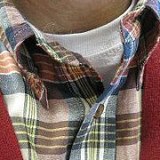#1 2009-02-28 09:03:10
- Decline & Fall
- Ivyist At Large

- Posts: 850
birth of the weejun
More archive digging. Enjoy.
THE BIRTH OF THE WEEJUN (OR A PENNY FOR YOUR THOUGHTS) AS TOLD BY HARVEY EVANS,
A FORMER EXECUTIVE AT L.B. EVANS SLIPPER CO., FITCHBURG, MASS.
Phil Danze
661 words
17 April 1995
Footwear News
77S
English
Copyright 1995 Fairchild Publications, Inc. All Rights Reserved
It was sometime around 1936 when a fellow walked into the office of L.B. Evans Slipper Co., the oldest
maker of footwear in America, and said to a young man named Harvey Evans, ``Look what I got. I brought
them back from Norway.'' And Evans, fresh out of Colby College up in Maine, looked at a pair of raw,
untanned, laceless shoes and asked, ``What are they?'' What Harvey Evans saw was neither fish nor fowl,
not a shoe or a slipper, but maybe a little of both. Harvey and his friend called them Norwegian slippers for
lack of a better name. Then the fellow from Norway said, ``You think you can make these things? They're
kind of nice on your feet.'' Harvey Evans saw how the shoes were stitched and said, ``They've got lots of
handsewing on them. They look like something that Bass would handle.'' Bass at the time was a producer of
up-to-the-knee hunting boots, which also required handsewing. ``You don't think you'd like to give them a
try?'' said the fellow from Norway. ``Not really.
My superintendant can do handsewing and I guess he could teach four or five of our people to handsew
too, but you know, we (L.B. Evans) have been around since 1804, so I guess you can say we've already
developed our niche. You can leave them here though. You never know what'll turn up.'' What did turn up, or
rather, who did turn up was a buyer from Benoit's out of Portland, Maine. His name was Norm Hodgdin. ``I
like these Norway slippers a lot,'' said Hodgdin. ``You sure you can't make me a bunch?'' By then Harvey
Evans had spoken to his superintendant who was willing to start a handsewn line of laceless shoes, but it
seemed it just wasn't in the cards for L.B. Evans to go the laceless route. But Harvey was willing to help out
a friend and so he and the buyer headed off to the offices of Bass. ``What you got?'' said John Bass, seated
behind his desk. Norm Hodgdin said he wanted to place an order for 150 pairs of these Norwegian slippers
for Benoit stores. So John Bass filled out an order for that amount, and that was a deal. Six months went by
and Norm Hodgdin returned to Bass and told John Bass he had still not filled his order for the laceless
shoes. Promptly Bass removed the order from his top drawer and said, ``This the order you mean? You
really want us to do this thing?'' ``I do,'' said Hodgdin as solemnly as if he were taking a vow. ``Alright then,
you've got it,'' said Bass. And the shoes were produced. Not in a raw yellow but in Bass' chocolate brown
and handsewn in all the right places. Norm Hodgdin, Benoit's buyer, put the shoes in two Maine college
town stores, at Bowden College, Brunswick, and Bates College, Lewiston. In a week both stores sold the
line out. Next Hodgdin put the shoes in his Chapel Hill unit in North Carolina. Same thing happened. Sold
out at $3.49 a pair. Next Bass was putting a penny in the shoe's front strap. Not in all of them but in some of
them. And, it was gimmick, for sure, but one that brought the Bass Weejun (short for Norwegian) much
attention...and the race was on. College kids started scouring the downtowns looking for ``penny mocs.'' The
Weejun swept the country like a prairie fire. The rest is history. A penny wasn't worth much, even in those
days, but to Bass those penny mocs had to be worth a fortune.
"I like bars just after they open in the evening. When the air inside is still cool and clean and everything is shiny. The first quiet drink of the evening in a quiet bar-that's wonderful."
— Raymond Chandler
#2 2009-02-28 11:41:38
- Taylor McIntyre
- Son of Ivy...

- Posts: 342
Re: birth of the weejun
... And this is why we rule the Net.
My deep thanks to Brother D&F -
- Soul Deep.
#3 2009-02-28 16:32:37
- Horace
- Member

- Posts: 6436
Re: birth of the weejun
Great article.
""This is probably the last Deb season...because of the stock market, the economy, Everything..." - W. Stillman.
#4 2009-02-28 17:57:37
- Tony Ventresca
- Member

- Posts: 5132
Re: birth of the weejun
Extraordinary. But all the best ideas are like that, aren't they? Just the crazy obssession of one guy that suddenly everyone realizes just makes sense.
#5 2009-03-02 15:11:53
- TheWeejun
- Member

- Posts: 946
Re: birth of the weejun
Brilliant. An unlike the 80s fashion mag rehashing, smacks of being the real story.
You on Lexus Nexus digging up that stuff?
The Weejun
"Mr. Weejun is a beast." 1966
www.theweejun.com
theweejun.tumblr.com
